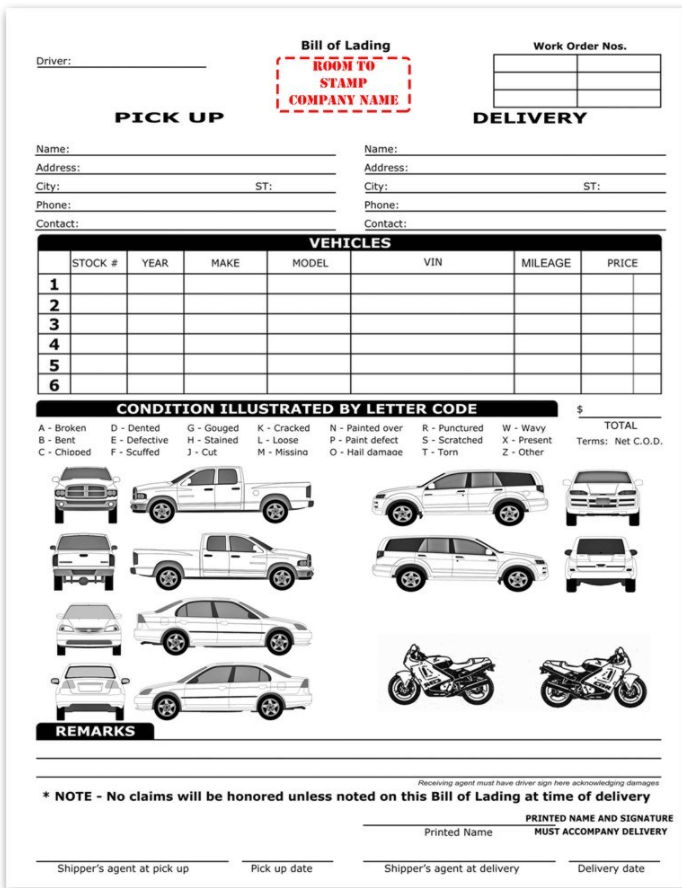Very few documents are involved if you ever need to ship a car, but one that plays a key role is the shipping Bill of Lading, often referred to by the BOL acronym. It’s also a document that is required in many other industries.
In this article, we’ll be giving you a Bill of Lading definition, looking closely at this crucial document, exploring what it is, when you might use one, why it’s so important, what information it contains, and more.
What is a Bill of Lading?
A Bill of Lading is a required document if you want to move a freight shipment. It serves many different purposes, such as a receipt, contract, and document of title. Details include the type, quantity, and destination of the goods, for example, a car being shipped from Nebraska to Tulsa. Below is an example of what an auto transport Bill of Lading looks like.
Who issues the Bill of Lading? In the case of an auto transport service, the Bill of Lading is issued by the carrier.
A BOL can act as a receipt, a contract, and a document of title. It will contain details as to the type, quantity, and destination of the goods being carried. When the carrier delivers the goods at the prearranged destination, it acts as a shipment receipt.
This documentation accompanies the products being shipped, no matter the type of transportation, whether by train, plane, or auto transport truck and trailer. An authorized representative from the carrier, shipper, and receiver must sign this document.
Let’s give you an example. A private individual wants to transport their custom Cadillac via an auto transport carrier from their current home in Los Angeles to Montana. Before the carrier loads the car you and the driver have to sign the Bill of Lading. If you can’t be there for the pick-up, your representative has to sign on your behalf. Upon delivery of the vehicle, you and the truck driver have to perform a second inspection, after which you’ll be given a copy of the original BOL.
A car Bill of Lading is a legally binding document that provides the driver and the carrier with all the information needed to process the shipment and invoice correctly. It also happens to be one of the most critical documents in the chain of shipping your vehicle.
We’ll look at bills of lading with reference to our auto transport service a little further down the page. First, let’s look at BOLs in general.
What are the different types of Bill of Lading in shipping?

There are a number of different types of B/L. However, they can be divided into two main categories: negotiable and non-negotiable documents. A negotiable BOL can be transferred to another party. In contrast, a non-negotiable B/L can only be consigned to a named party who has to be the cargo’s final recipient.
Before we look at the different types of bills of lading, we should first explain the consignee’s role.
Who is the consignee of the Bill of Lading?
The consignee is the person who is entitled to receive the shipment from the carrier. The type of Bill of Lading determines how the goods are transferred.
A straight bill, for example, identifies the consignee as the actual person. Depending on the destination country’s laws, they may be required to show the original bill if they want to claim the goods. More often than not, the consignee will have to make an advance payment before receiving the goods.
If the bill is negotiable, it will state the consignee as a named party that has been pre-determined by either the carrier, a bank or the importer of goods. The consignee will pay for the goods using credit or cash against the production of the documents.
A bearer Bill of Lading states that the consignee is the person in possession of the original Bill of Lading and can be negotiated by physical delivery.
Straight Bill of Lading
A straight Bill of Lading is specified to a particular party, and they cannot re-assign it to anyone else. The party only has to take delivery of the cargo, and they cannot sell it by transferring the BOL into another party’s name.
Order BOL
This is one of the most common Bills of Lading used for ocean shipments. It is issued to the consignee or to his order. The named consignee is, therefore, the owner of the cargo, or it’s possible for them to request that the shipment is delivered to another party. They do this by endorsing the B/L to that party.
An order BOL is a negotiable document as the title or ownership can be transferred to someone else.
Bearer B/L
A bearer Bill of Lading is a document in which the bearer of the bill is the owner of the cargo and there is no consignee named. This type of document is not used very often as there are huge risks involved.
Again, this is a negotiable document as the title or ownership of the bill can be transferred.
Through Bill of Lading
This is a legal document that allows direct delivery of the cargo from one location to another. It will enable the shipment to pass domestic and international borders because it serves as a contract of carriage and receipt of the cargo.
Clean Bill of Lading
This bill states that the cargo is in good condition aboard the vessel and cannot explicitly declare a defective condition of the packaging or the goods inside.
On-board or shipped Bill of Lading
This document is issued when the cargo is onboard the vessel and binds the shipowner to the carrier directly.
Received-for-shipment Bill of Lading
This bill is sent to the carrier by an agent or middleman. It confirms that the goods have been received but not yet laden onto the ship.
Combined transport or multimodal Bill of Lading
This bill states that the cargo is transported by multiple modes, for example, by sea, land, or air.
Dirty Bill of Lading
There is a clause in this type of bill that allows the ship owner to declare the cargo’s condition to be “dirty” when he finds out that there is broken cargo, the quantity of goods specified is incorrect, or there has been significant damage to the packaging.
Inland Bill of Lading
These are often the first transportation documents issued for an international shipment. They are used for cargo shipments by rail or road, but not sea.
Ocean Bill of Lading
This document is for shipping goods overseas. It authorizes the holder or another party to take possession of the goods. An ocean Bill of Lading can be a straight Bill of Lading or consigned to order bill.
Air waybill
This is the equivalent of an ocean Bill of Lading used in air transport. However, it’s slightly different from an ocean Bill of Lading because it cannot be negotiable. In other words, it cannot be consigned to order.
What is the purpose of a Bill of Lading?
A Bill of Lading is one of the most essential freight shipping documents, whether you’re shipping a box of potato chips, a pallet of roofing tiles, or your precious Ford F-Series. It’s important because it fulfills three primary purposes.
Evidence of a contract between shipper and carrier
A Bill of Lading is a document that provides the driver and carrier details of your freight shipment. These details include what goods you’re shipping, where the load is coming from, and where it’s going.
For example, you might want to ship your Mercedes SLK from Tampa, Florida, to Sacramento, California.
It is not a contract but evidence of a contract because you would agree upon the shipping contract before the bill is issued.
The carrier for your shipment provides the B/L when your vehicle is picked up and is delivered to the consignee upon delivery.
Receipt of freight services and goods
The shipping carrier or their agent issues the Bill of Lading. It’s given to the shipper in exchange for receiving the freight. It is proof that the carrier has received the freight in good condition, as provided by the shipper.
If you’re shipping a car, the carrier will give you a signed copy of the bill as proof of carrier liability in the event that the shipment is lost, damaged, or destroyed.
Document of title, or ownership of goods
A Bill of Lading means that the goods may be transferred to the holder of the BOL, in other words, the carrier, and can then be transferred to someone else (the consignee). When you ship a car the consignee is yourself, unless you’re sending the vehicle to a third party, for example, if you’ve sold it.
A Bill of Lading includes a lot of important information. For example:
- The shipper and consignee names
- Name of the carrier
- An itemized list of the goods being transported
- Number of packages and type of packaging
- Weight and/or volume of the cargo
- Each package’s freight class
- Terms of payment
- Special handling instructions
- Freight rate and amount
- Pictures that describe the condition of the items being shipped (in the case of auto transport)
Should you need to claim compensation (a very rare occurrence when it comes to auto transport) due to loss or damage, or for any disputes regarding ownership of the freight, the Bill of Lading plays a vital role. If you don’t have a correctly completed BOL, you could face a major headache if you want to receive compensation for your freight loss or damage.
What information is in a Bill of Lading?
A Bill of Lading is a legally binding contract, and it must be correctly completed. You’ll find the following details in most BOL’s:
- Names and addresses: These will be for the shipped and receiver (consignee) and should both be legible.
- Purchase orders or reference numbers: In the case of auto transport, this will be your booking number.
- Special instructions: These may be needed to ensure the integrity of the package.
- Date of pick-up and delivery
- Description of the items: This might include the quantity of goods, dimensions, weight, and information about the material. In the case of an auto transport company, there is a section where you can mark the condition of your vehicle by letter code.
- Packaging type: It might be cartons, crates, drums, or pallets during shipping.
- NMFC (National Motor Freight Traffic Association) code: This code corresponds to the freight class of the shipment according to its density, ease of handling, liability, and value.
- Department of Transportation hazardous material destination: Hazardous materials being transported have to be disclosed along with the necessary handling measure.
What is the differences between a freight bill and a Bill of Lading?
A freight bill might sound like it’s similar to a Bill of Lading, but the two documents are actually very different. A freight bill provides additional information to support the Bill of Lading. This information is more of a financial nature. A freight bill also clarifies other details in the Bill of Lading.
A freight bill is typically used by accountants and others who might be interested in a more detailed account of the shipment process.
A Bill of Lading is a legally binding document, whereas a freight bill isn’t a document of service level agreement. A Bill of Lading can be used to settle disputes between shippers and carriers, whereas a freight bill isn’t generally considered as evidence.
A freight bill will also contain information not usually included in the Bill of Lading, for example, information about additional costs incurred during transport.
What is the difference between a delivery order and a Bill of Lading?
This is another instance in which there is often confusion, whereas, these two documents are quite different.
A delivery order is also a legal document, like a Bill of Lading. The difference, however, is in the information it contains and who it is intended for. A delivery order instructs the recipient to release supplies or goods to the designated individual or organization named in the order. In the case of US contract law, you’ll find a clear description of this document in the Uniform Commercial Code.
Delivery orders are commonly used in international trade, where they authorize the release of imported cargo. The person who completes a delivery order is often called the consignor.
It should not be confused with a Bill of Lading. It’s a document that a carrier sends to the consignor to confirm delivery of the goods to the person specified and at a specific address.
How does an auto transport Bill of Lading work?
Bills of lading have been used for many years when it comes to transporting goods by sea. The term is also now included for all forms of cargo transportation, whether by sea, air, or land.
When you ship a car using auto transport, you’ll be asked to sign a Bill of Lading at pick-up and delivery. Essentially, this document is a contract between the carrier and the shipper, which is you. In the auto transport industry, it is also known as the vehicle inspection report.
How a Bill of Lading is used in the auto transport industry
When the carrier picks up your vehicle, they will inspect it with you. If there is any previous damage, you must note this on the truck Bill of Lading during the inspection. Both you and the driver will sign the document, and you’ll get a copy. When your vehicle arrives at its destination, you can compare its condition with this copy.
In the rare case of any damage occurring to your car while it was on the trailer, the vehicle inspection report, or auto carrier Bill of Lading, will make claims for the damage more straightforward.
When the carrier delivers your vehicle, you and the driver can go over your car again. Any damage that you didn’t note on the Bill of Lading at pick-up will be the claim to the insurance.
You’ll be asked to accept receipt of your vehicle, but before you sign off, be sure to go over everything carefully. It’s also important to read the Bill of Lading form for auto transport carefully and make sure all the terms therein are what you agreed to when you made your booking.
Why is a Bill of Lading important when you ship a car?
It’s a vital document because it records your vehicle’s condition when it was picked up and delivered. It also confirms the addresses, phone numbers, and contacts and is a record of your transport agreement.
It is also the only documentation an insurance company will accept, should you need to make a claim. However, we should point out that auto transport is a very safe and secure way to ship a car, and the chance of any damage occurring is minimal.
What is typically found on an auto transport Bill of Lading

As you can see, the information contained in an auto transport Bill of Lading is easily organized.
At the top of the document is the work order no, name of the driver, and usually a company stamp.
The next details are transit directives. In layman’s terms, these are where the vehicle is coming from and going to. Then there will be the information pertaining to the vehicle, or vehicles, being shipped. Generally, the details will include the make, model, color, value, and mileage. In some cases, the VIN of the car will also be added. The mileage is significant because it demonstrates that your vehicle was not driven other than when it was loaded and unloaded.
The next section of the Bill of Lading form for car transport contains the most crucial information as it is the vehicle condition report. Using the pictures of the cars, you can mark where there is damage such as dings, dents, scratches, and marks. You can indicate the severity of the damage using one of the following letters:
- A: Broken
- B: Bent
- C: Chipped
- D: Dented
- E: Defective
- F: Scuffed
- G: Gouged
- H: Stained
- J: Cut
- K: Cracked
- L: Loose
- M: Missing
- N: Painted over
- P: Paint defect
- O: Hail damage
- R: Punctured
- S: Scratched
- T: Torn
- W: Wavy
- X: Present
- Z: Other
There is also a space to make any other comments.
When the carrier collects your vehicle, the driver will ask you to sign the vehicle condition report/ vehicle delivery receipt, after inspecting your vehicle and noting any damage. The driver also has to sign before giving you a copy of the document. The person signing the document has to be over 18 years of age.
Is any other documentation required when you ship a car?
No other documentation is required when you ship a car across the United States. However, different rules apply if you are shipping a vehicle from Hawaii to the mainland.
Specific documentation is required, alongside the Bill of Lading.
Lienholder authorization
If you’re still paying off your vehicle loan, the lienholder, in other words, your loan provider, will require you to get formal authorization before shipping a car.
Absent owner authorization
If you’re unable to deliver your car to the port, or the vehicle is in joint names, the absent owner must authorize shipment.
Title and registration
Your vehicle title is proof of ownership, while the registration means your vehicle has all the required documentation in your home state.
Photo ID
A government-issued ID is usually all that’s needed.
Certificate of safety inspection
When you register a vehicle in Hawaii, it must undergo a safety check to confirm it is roadworthy. The following checks are made:
- Steering
- Wheel alignment
- Suspension
- Tires
- Wheels and rims
- Exhaust system
- Fuel intake system
- Service brakes
- Parking brakes
- Lamps
- Horn
- Window tint
- Windshield
- Windshield wipers
- Rearview mirrors
- Door latches
- Seats and belts
- Fendersbumpers
- Floor plan
- Body items
- Speedometer and odometer
If you’re interested in shipping a vehicle, please get in touch with our shipping advisors today. Rest assured, we provide all the correct documentation to ensure your auto transport experience is a positive one. Request an instant quote online, by phone or Live Chat.






